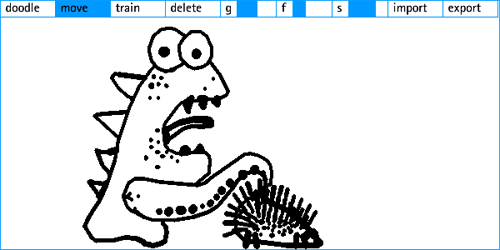April 24, 2005
| Attention Must Be Paid >>
Spore Now

I finally gave in and looked at Processing.org, the programming language for artists, and spent a good few hours today agape at the beauty and creativity on display in the exhibitions. Then I encountered Moovl, which stopped me in my tracks.
Remember the Soda Constructor? Well, they’ve taken that and made it mindblowing.
Moovl applies the laws of physics to your doodles. Remember that Gamespy article about Spore, Will Wright’s new game? The article describes character creation in Spore thusly:
The 3D version of the creature editor was amazing, in that the creature was totally configurable. You could stretch and pull and tug or fatten it any way you liked, almost like working with clay. More importantly, you could add functional elements, like heads, mouths, eyes, tails, fins, claws, even legs and feet. Wright proceeded to add not two, but three legs to his creature. Then he let it loose.Now, suddenly, his creature could walk. And he did so — he walked right out of the sea and onto the land. This incredible moment in the history of evolution was made even more remarkable by the technology behind it: the game had figured out, procedurally, how a creature would walk if it had three legs (it was a kind of lopsided gait, if you’re curious, with three steps: left, right, then middle.) No 3D modeler created the creature, and no 3D animator was required to make it move around — it was all created out of a gamer’s whim and a computer program smart enough to make it work.
Moovl can basically do that. Not in 3D, but it’s cool enough in 2D that I don’t mind that right now. Draw a hilariously simple doodle of a three-legged blob, train three of the feet to move, and voila, you’ve got a creature.
The official site is targeted to children, and the examples there aren’t very inspiring, even though the applet’s slightly better. I prefer the pared-down version and its examples over at Processing, especially “lovehurts” and “fistycuffs.”
Part of what’s amazing to me is how much those simple doodles in motion seem to suggest narratives. The story and the interactivity unite in these very logical rules and relationships which you have the power to build on or alter.
Something tells me that’s going to be the storytelling model that ultimately turns video games inside out.
More amazing stuff from Processing:



Comments
That's sooo cool!
One thing I love about the Moovl characters is that their 'intelligence' is embedded in their geometry, you know? You don't make all the parts then write a high-level program: You tell each part in particular what to do, and then it's the interaction that creates cool high-level effects.
Some cog scientists have theorized that much more of OUR intelligence is bound up in our bodies than we realize -- and that the 'brain in the vat' model of AI would never work, at least not w/ any kind of human-style intelligence, b/c our problem-solving skills, our learning processes, our emotions, & everything else are all totally bound up in & dependent on the fact that we've got arms & legs & hormones & all that. Cool.
Man, this blog got rockin' while I was away...